Obtaining Nutraceutical Compounds from Agroindustrial Waste by Biotransformation with Pleurotus djamor
Abstract
1. Introduction
2. Results
2.1. Biological Efficiency
2.2. Proximal Chemical Analysis of Substrate Mixtures
2.3. Development of P. djamor
2.4. Texture of the Basidiomas of P. djamor
2.5. Lignocellulosic Content of Substrates
2.6. Phenolic Compounds and Antioxidant Capacity in P. djamor
2.7. Non-Phenolic Secondary Metabolites of P. djamor
3. Discussions
3.1. Biological Efficiency (BE)
3.2. PCA of Substrate Mixtures
3.3. The Morphological Impact
3.4. Texture of P. djamor
3.5. Lignocellulosic Content of P. djamor
3.6. Phenolic Compounds and Antioxidant Activity
3.7. Non-Phenolic Secondary Metabolites of P. djamor
4. Materials and Methods
4.1. Reagents and Instruments
4.2. Biological Treatment
4.3. Proximate Chemical Analysis of Substrates
4.4. Lignocellulosic Content of Substrates
4.5. Texture of P. djamor
4.6. Methanolic Secondary Metabolites in P. djamor and Substrates
4.7. Non-Phenolic Secondary Metabolites of P. djamor
4.8. Statistical Analysis
5. Conclusions
Author Contributions
Funding
Data Availability Statement
Acknowledgments
Conflicts of Interest
Abbreviations
| BE | Biological efficiency |
| NFE | Nitrogen-free extract |
| CF | Crude fiber |
| SD | Standard deviation |
| N | Newtons |
References
- Kumar, S.; Pandey, A.K. Chemistry and Biological Activities of Flavonoids: An Overview. Sci. World J. 2013, 2013, 162750. [Google Scholar] [CrossRef]
- Sandargo, B.; Chepkirui, C.; Cheng, T.; Chaverra-Muñoz, L.; Thongbai, B.; Stadler, M.; Hüttel, S. Biological and chemical diversity go hand in hand: Basidiomycota as source of new pharmaceuticals and agrochemicals. Biotechnol. Adv. 2019, 37, 107344. [Google Scholar] [CrossRef]
- Zhang, J.; Liu, M.; Yang, Y.; Lin, L.; Xu, N.; Zhao, H.; Jia, L. Purification, characterization and hepatoprotective activities of mycelia zinc polysaccharides by Pleurotus djamor. Carbohydr. Polym. 2016, 136, 588–597. [Google Scholar] [CrossRef]
- Nayak, H.; Kushwaha, A.; Behera, P.C.; Shahi, N.C.; Kushwaha, K.P.; Kumar, A.; Mishra, K.K. The Pink Oyster Mushroom, Pleurotus djamor (Agaricomycetes): A Potent Antioxidant and Hypoglycemic Agent. Int. J. Med. Mushrooms 2021, 23, 29–36. [Google Scholar] [CrossRef]
- El-Ramady, H.; Abdalla, N.; Badgar, K.; Llanaj, X.; Törős, G.; Hajdú, P.; Eid, Y.; Prokisch, J. Edible Mushrooms for Sustainable and Healthy Human Food: Nutritional and Medicinal Attributes. Sustainability 2022, 14, 4941. [Google Scholar] [CrossRef]
- Pineda-Alegría, J.A.; Peña-Rodríguez, L.M.; Cardoso-Taketa, A.; Sánchez, J.E.; Torres-Acosta, J.F.D.J.; Hernández-Bolio, G.I.; Ortiz-Caltempa, A.; Villarreal, M.L.; Aguilar-Marcelino, L. 1H-NMR Metabolomic Study of the Mushroom Pleurotus djamor for the Identification of Nematocidal Compounds. Pharmaceuticals 2024, 17, 580. [Google Scholar] [CrossRef]
- Amirullah, N.A.; Abdullah, E.; Zainal Abidin, N.; Abdullah, N.; Manickam, S. Therapeutic potential of mushrooms: A review on NF-κB modulation in chronic inflammation. Food Biosci. 2024, 62, 105059. [Google Scholar] [CrossRef]
- Yang, W.; Guo, F.; Wan, Z. Yield and size of oyster mushroom grown on rice/wheat straw basal substrate supplemented with cotton seed hull. Saudi J. Biol. Sci. 2013, 20, 333–338. [Google Scholar] [CrossRef]
- Kalač, P. A review of chemical composition and nutritional value of wild-growing and cultivated mushrooms. J. Sci. Food Agric. 2013, 93, 209–218. [Google Scholar] [CrossRef]
- Bellettini, M.B.; Fiorda, F.A.; Maieves, H.A.; Teixeira, G.L.; Ávila, S.; Hornung, P.S.; Júnior, A.M.; Ribani, R.H. Factors affecting mushroom Pleurotus spp. Saudi J. Biol. Sci. 2019, 26, 633–646. [Google Scholar]
- Valenzuela-Cobos, J.D.; Grijalva-Endara, A.; Marcillo-Vallejo, R.; Garcés-Moncayo, M.F. Production and characterization of reconstituted strains of Pleurotus spp. Cultivated on different agricultural wastes. Rev. Mex. Ing. Quim. 2020, 19, 1493–1504. [Google Scholar] [CrossRef]
- Cruz-Moreno, B.A.; Pérez, A.A.F.; García-Trejo, J.F.; Pérez-García, S.A.; Gutiérrez-Antonio, C. Identification of Secondary Metabolites of Interest in Pleurotus djamor Using Agave tequilana Bagasse. Molecules 2023, 28, 557. [Google Scholar] [CrossRef] [PubMed]
- Vega, A.; Franco, H. Productivity and quality of the fruiting bodies of edible mushrooms Pleurotus pulmonarius RN2 and P. djamor RN81 and RN82 grown on different lignocellulosic substrates. Inf. Tecnol. 2013, 24, 69–78. [Google Scholar] [CrossRef]
- Baktemur, G.; Kara, E.; Yarar, M.; Yilmaz, N.; Ağçam, E.; Akyildiz, A.; Taşkin, H. Yield, quality and enzyme activity of shiitake mushroom (Lentinula edodes) grown on different agricultural wastes. Not. Bot. Horti Agrobot. 2022, 50, 12553. [Google Scholar] [CrossRef]
- Daşdelen, O.; Shimira, F.; Kara, E.; Baktemur, G.; Taşkin, H. Effects of different agricultural wastes on yield and quality in Pholiota nameko cultivation. Int. J. Agric. Environ. Food Sci. 2022, 6, 537–544. [Google Scholar] [CrossRef]
- Karmani, M.; Subramaniam, G.; Sivasamugham, L.A.; Cheng, W.H.; Wong, L.S. Effects of Different Substrates on the Growth and Nutritional Composition of Pleurotus ostreatus: A Review. J. Exp. Biol. Agric. Sci. 2022, 10, 481–486. [Google Scholar] [CrossRef]
- Mkhize, S.S.; Cloete, J.; Basson, A.K.; Zharare, G.E. Performance of Pleurotus ostreatus mushroom grown on maize stalk residues supplemented with various levels of maize flour and wheat bran. Food Sci. Technol. 2016, 36, 598–605. [Google Scholar] [CrossRef]
- Roblero-Mejía, D.O.; Aguilar-Marcelino, L.; Sánchez, J.E. Effect of substrate variation on the productivity of two strains of Pleurotus spp. Sci. Fungorum 2021, 52, e1377. [Google Scholar] [CrossRef]
- Sindhu, S.; Theradimani, M.; Vellaikumar, S.; Paramasivam, M.; Ramamoorthy, V. Development of novel rapid-growing and delicious Pleurotus djamor strains through hybridization. Arch. Microbiol. 2024, 206, 13. [Google Scholar] [CrossRef] [PubMed]
- Kotwaliwale, N.; Pramod, B.; Ajay, V. Changes in textural and optical properties of oyster mushroom during hot air drying. J. Food Eng. 2007, 78, 1207–1211. [Google Scholar] [CrossRef]
- Sánchez, C. Cultivation of Pleurotus ostreatus and other edible mushrooms. Appl. Microbiol. Biotechnol. 2010, 85, 1321–1337. [Google Scholar] [CrossRef]
- Nguyen, T.M.; Ranamukhaa, S.L. Effect of Different Culture Media, Grain Sources and Alternate Substrates on the Mycelial Growth of Pleurotus eryngii and Pleurotus ostreatus. Pak. J. Biol. Sci. 2020, 23, 223–230. [Google Scholar] [CrossRef]
- Hassan, N.A.; Supramani, S.; Sohedein, M.N.A.; Usuldin, S.R.A.; Klaus, A.; Ilham, Z.; Chen, W.-H.; Wan-Mohtar, W.A.A.Q.I. Efficient biomass-exopolysaccharide production from an identified wild-Serbian Ganoderma lucidum strain BGF4A1 mycelium in a controlled submerged fermentation. Biocatal. Agric. Biotechnol. 2019, 21, 101305. [Google Scholar] [CrossRef]
- Adebayo, E.A.; Azeez, M.A.; Alao, M.B.; Oke, M.A.; Aina, D.A. Mushroom Nanobiotechnology: Concepts, Developments and Potentials. In Microbial Nanobiotechnology. Materials Horizons: From Nature to Nanomaterials; Springer: Singapore, 2021; pp. 257–285. [Google Scholar] [CrossRef]
- Ferreira, I.; Barros, L.; Abreu, R. Antioxidants in Wild Mushrooms. Curr. Med. Chem. 2009, 16, 1543–1560. [Google Scholar] [CrossRef]
- de Medeiros, R.L.; Andrade, G.M.; Crispim, R.B.; Silva, N.N.d.S.; da Silva, S.A.; de Souza, H.A.N.; Zárate-Salazar, J.R.; de Medeiros, F.D.; Dantas, C.E.A.; Viera, V.B.; et al. Nutritional and antioxidant potential of Pleurotus djamor (Rumph. ex Fr.) Boedijn produced on agronomic wastes banana leaves and sugarcane bagasse substrates. Braz. J. Microbiol. 2024, 55, 1117–1129. [Google Scholar] [CrossRef]
- Puttaraju, N.G.; Venkateshaiah, S.U.; Dharmesh, S.M.; Urs, S.M.N.; Somasundaram, R. Antioxidant Activity of Indigenous Edible Mushrooms. J. Agric. Food Chem. 2006, 54, 9764–9772. [Google Scholar] [CrossRef] [PubMed]
- Barros, L.; Cruz, T.; Baptista, P.; Estevinho, L.M.; Ferreira, I.C.F.R. Wild and commercial mushrooms as source of nutrients and nutraceuticals. Food. Chem. Toxicol. 2008, 46, 2742–2747. [Google Scholar] [CrossRef]
- Dewanto, V.; Wu, X.; Adom, K.K.; Liu, R.H. Thermal Processing Enhances the Nutritional Value of Tomatoes by Increasing Total Antioxidant Activity. J. Agric. Food Chem. 2002, 50, 3010–3014. [Google Scholar] [CrossRef]
- Patel, P.; Sunkara, R.; Walker, L.T.; Verghese, M. Effect of Drying Techniques on Antioxidant Capacity of Guava Fruit. Food Nutr. Sci. 2016, 7, 544–554. [Google Scholar] [CrossRef]
- Fogarasi, M.; Socaci, S.A.; Dulf, F.V.; Diaconeasa, Z.M.; Fărcaș, A.C.; Tofană, M.; Semeniuc, C.A. Bioactive Compounds and Volatile Profiles of Five Transylvanian Wild Edible Mushrooms. Molecules 2018, 23, 3272. [Google Scholar] [CrossRef] [PubMed]
- Latimer, G.W. Official Methods of Analysis of AOAC International; AOAC International: Rockville, MD, USA, 2019. [Google Scholar]
- Nielsen, S.S. Food Analysis; Springer: Boston, MA, USA, 2010. [Google Scholar] [CrossRef]
- Cardador-Martínez, A.; Loarca-Piña, G.; Oomah, B.D. Antioxidant Activity in Common Beans (Phaseolus vulgaris L.). J. Agric. Food Chem. 2002, 50, 6975–6980. [Google Scholar] [CrossRef]
- Oomah, B.D.; Cardador-Martínez, A.; Loarca-Piña, G. Phenolics and antioxidative activities in common beans (Phaseolus vulgaris L.). J. Sci. Food Agric. 2005, 85, 935–942. [Google Scholar] [CrossRef]
- Deshpande, S.S.; Cheryan, M. Determination of phenolic compounds of dry beans using vanillin, redox and precipitation assays. J. Food Sci. 1987, 52, 332–334. [Google Scholar] [CrossRef]
- Brand-Williams, W.; Cuvelier, M.E.; Berset, C. Use of a free radical method to evaluate antioxidant activity. LWT Food Sci. Technol. 1995, 28, 25–30. [Google Scholar] [CrossRef]
- Re, R.; Pellegrini, N.; Proteggente, A.; Pannala, A.; Yang, M.; Rice-Evans, C. Antioxidant activity applying an improved ABTS radical cation decolorization assay. Free Radic. Biol. Med. 1999, 26, 1231–1237. [Google Scholar] [CrossRef]
- Figueroa-Pérez, M.G.; Rocha-Guzmán, N.E.; Pérez-Ramírez, I.F.; Mercado-Silva, E.; Reynoso-Camacho, R. Metabolite Profile, Antioxidant Capacity, and Inhibition of Digestive Enzymes in Infusions of Peppermint (Mentha piperita) Grown under Drought Stress. J. Agric. Food Chem. 2014, 62, 12027–12033. [Google Scholar] [CrossRef]
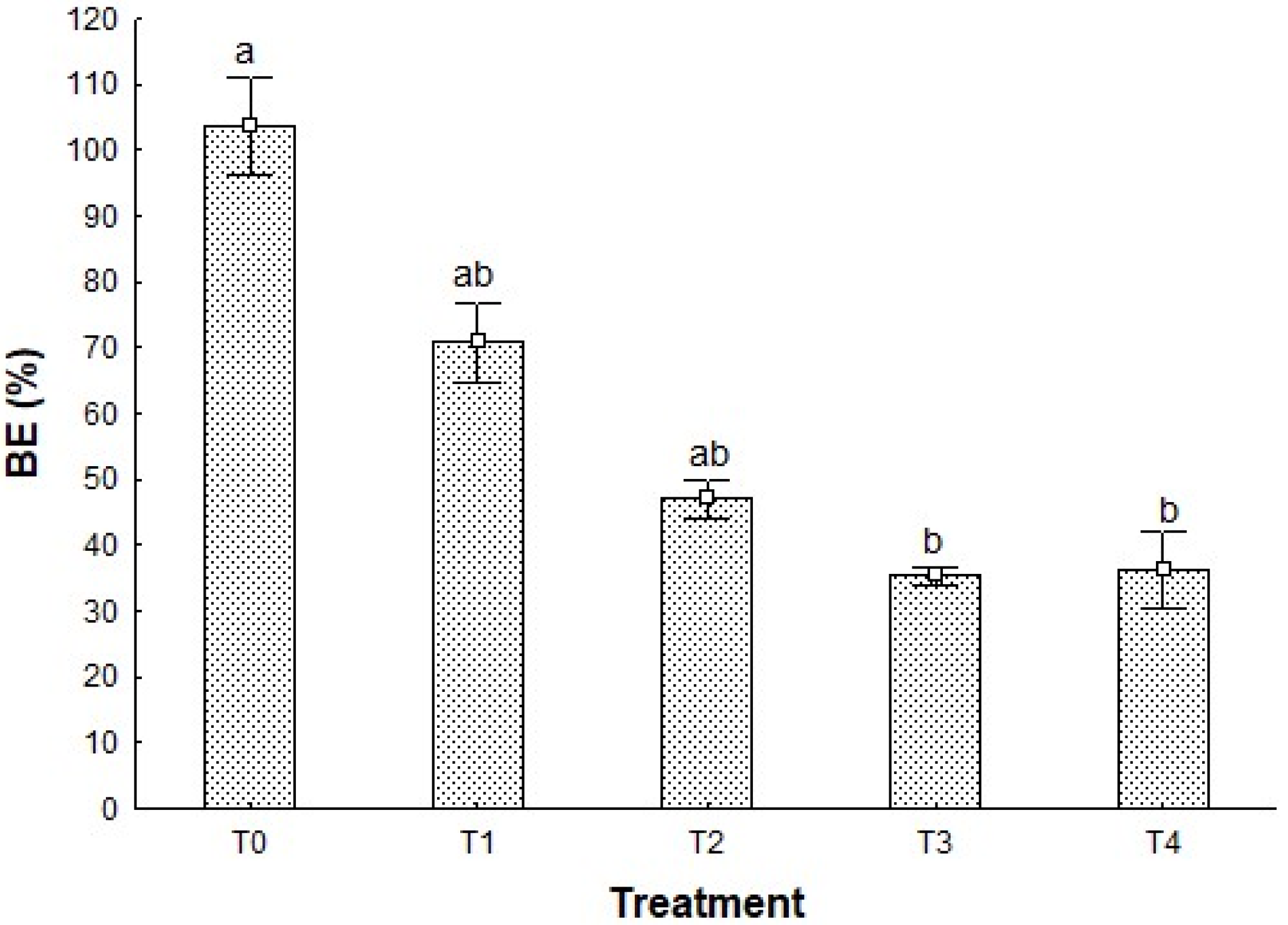
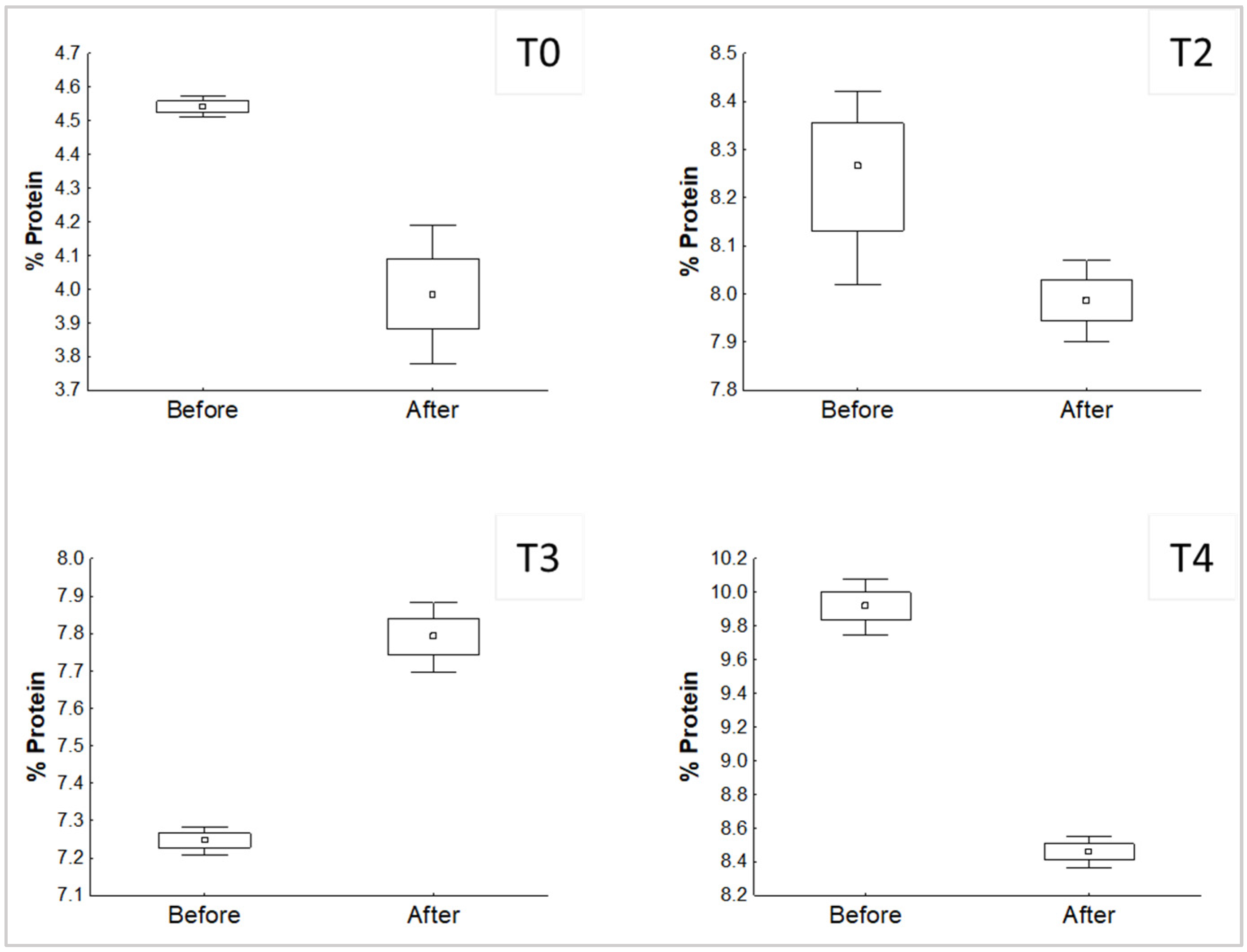
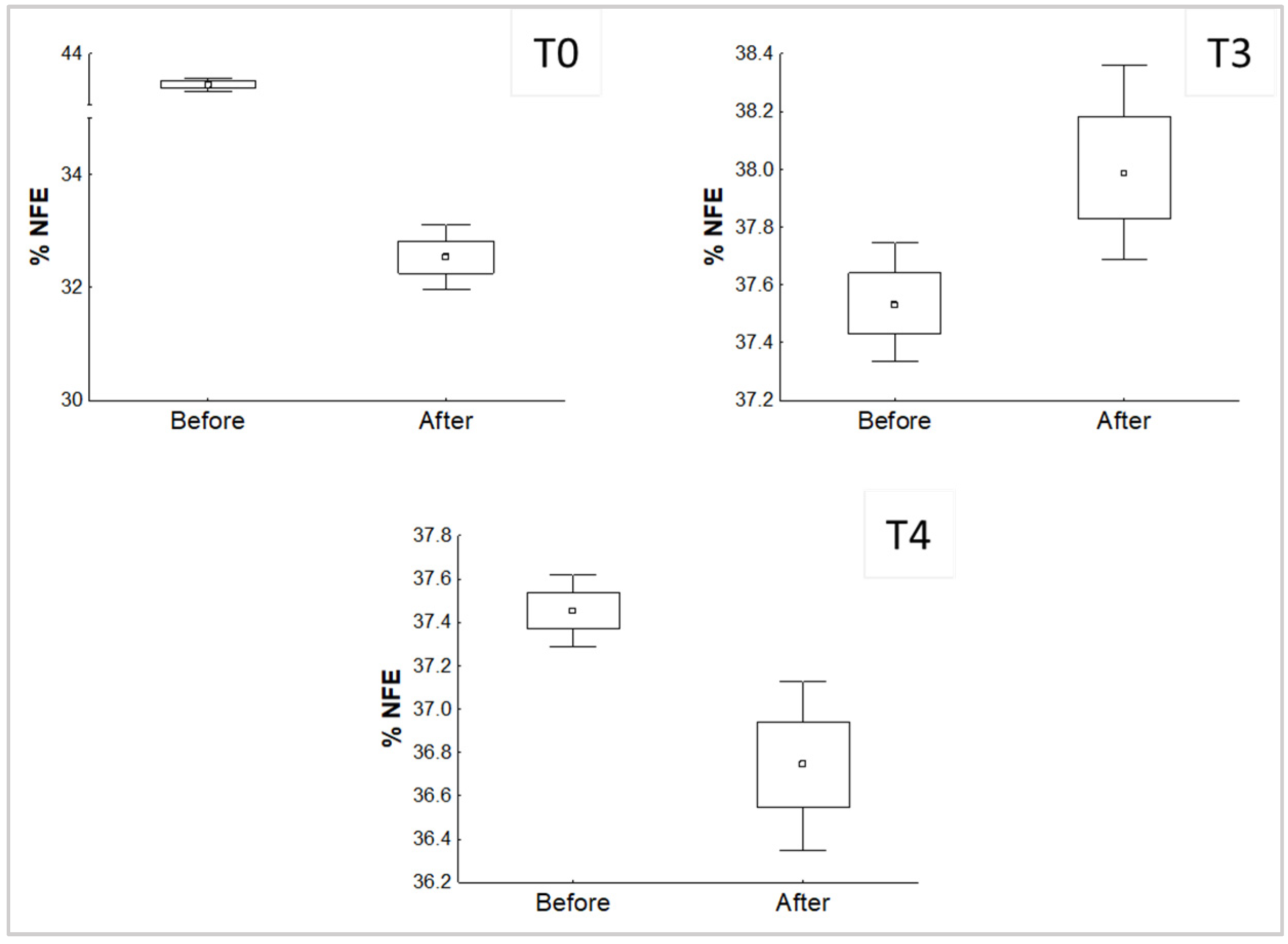
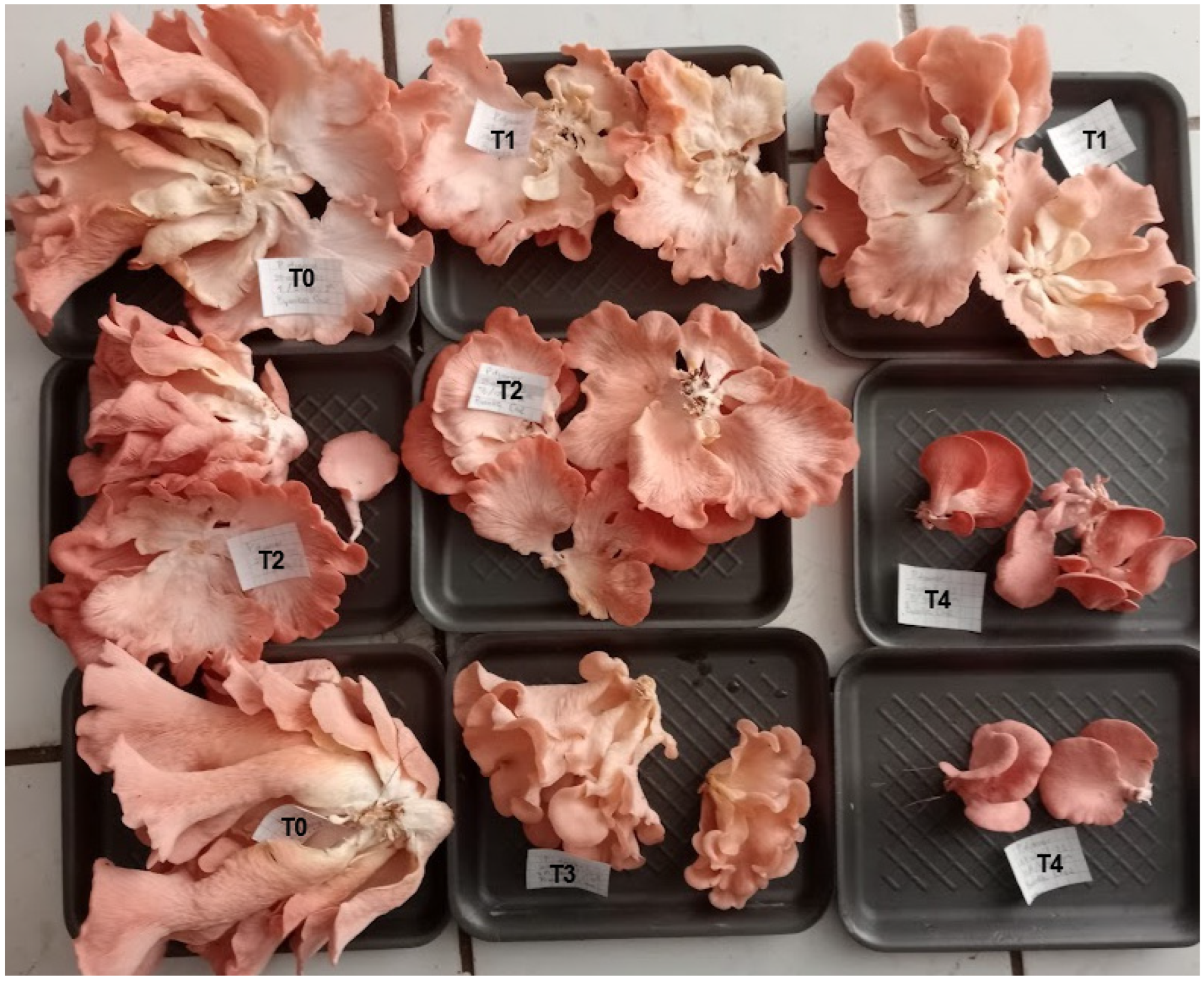
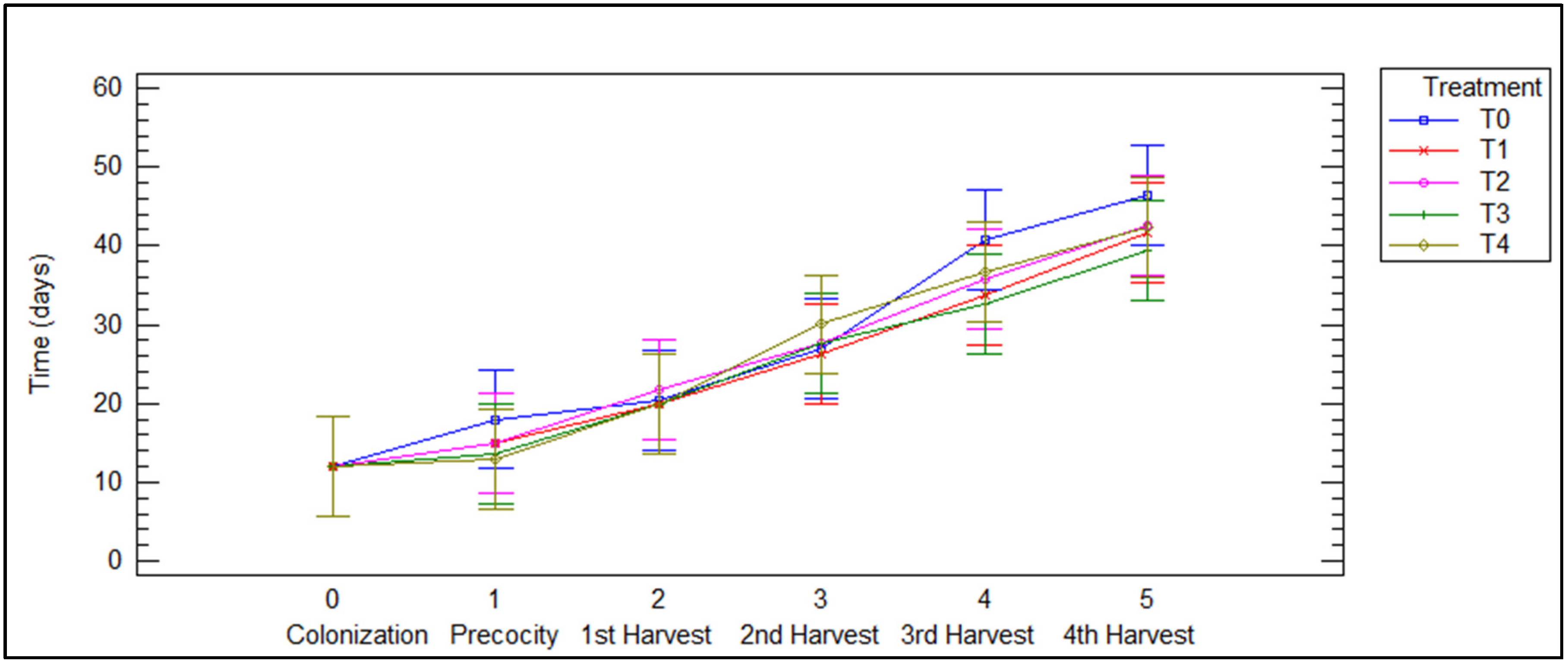
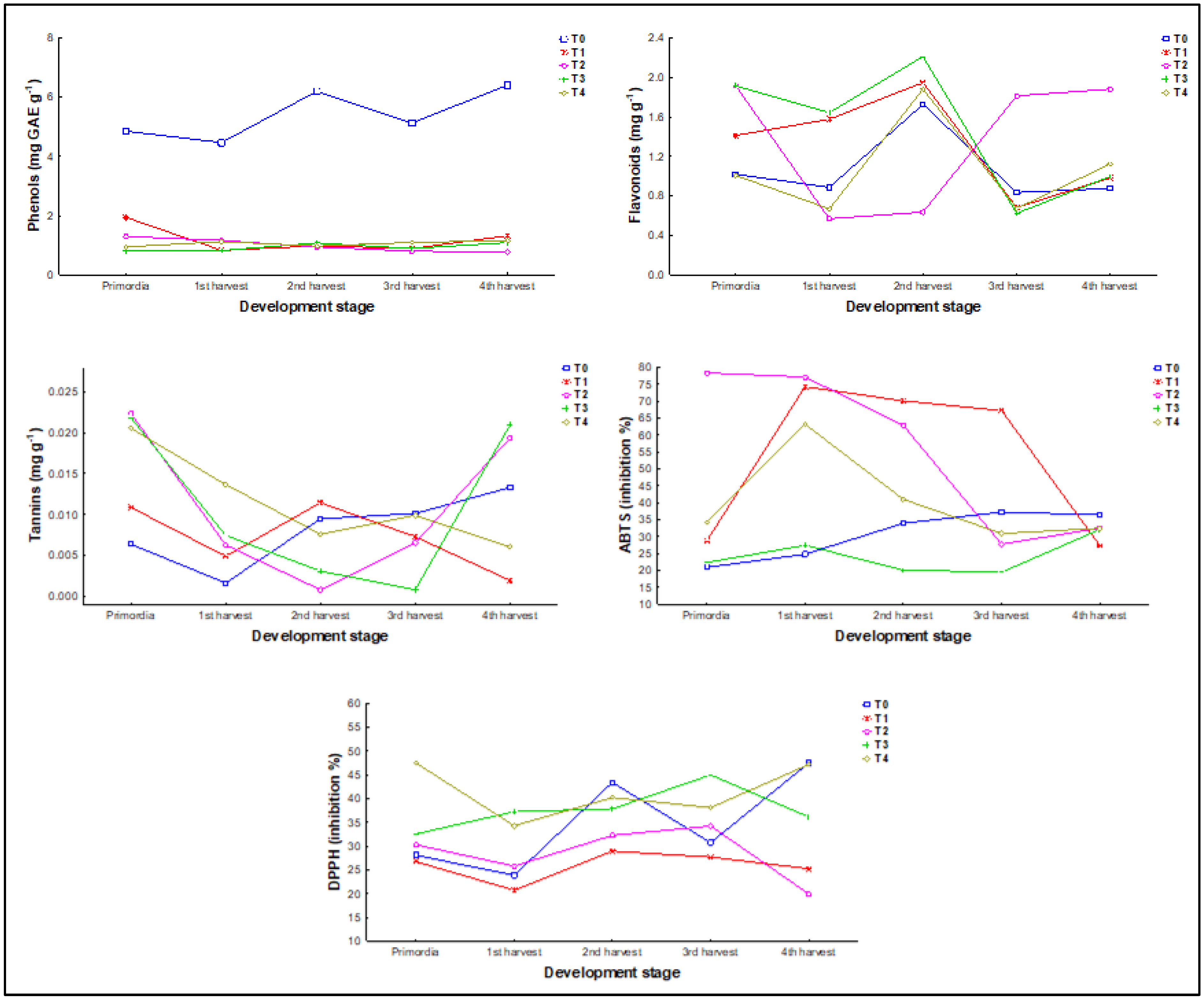
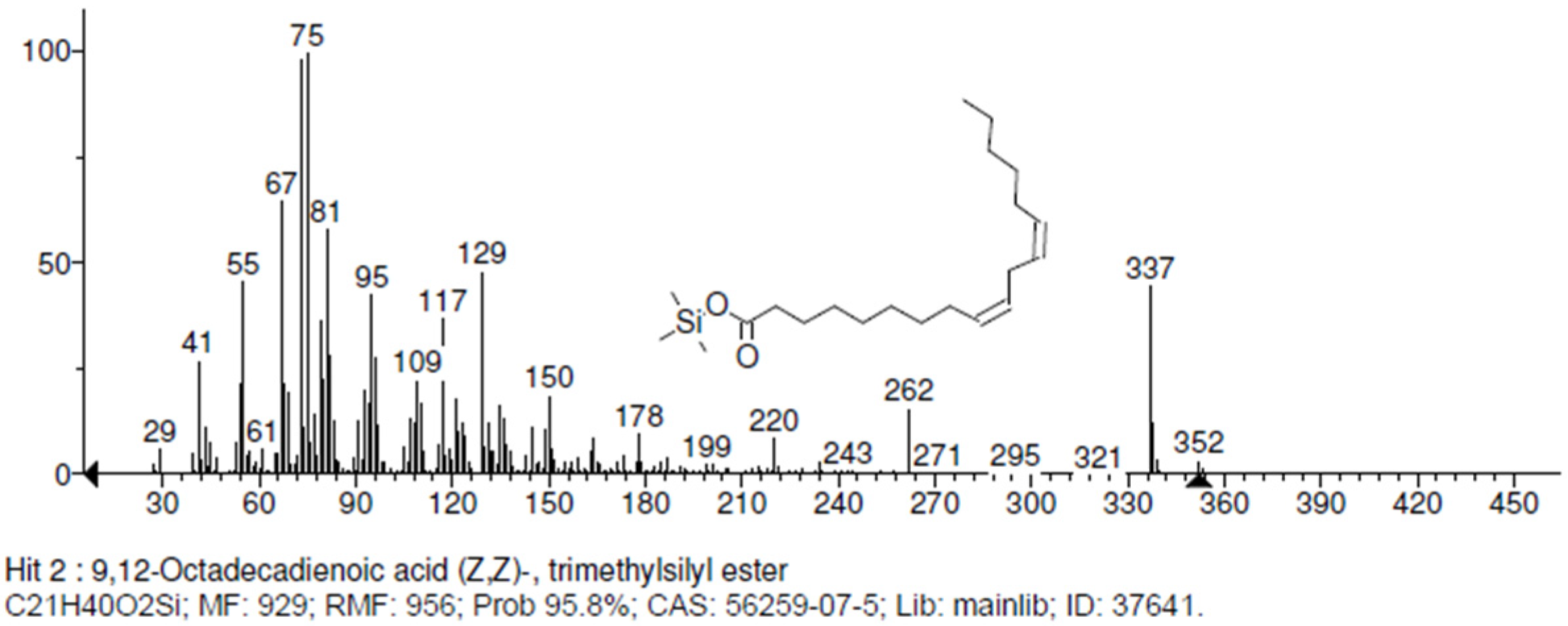
| Treatment | Moisture (% ± SD) | NFE (% ± SD) | Ethereal Extract (% ± SD) | Protein (% ± SD) | Ashes (% ± SD) | CF (% ± SD) |
|---|---|---|---|---|---|---|
| T0 | 7.54 ± 0.09 a | 43.4 ± 0.13 a | 0.52 ± 0.05 a | 4.54 ± 0.03 a | 19.02 ± 0.11 a | 32.45 ± 0.12 a |
| T1 | 6.84 ± 0.12 ab | 39.51 ± 1.31 ab | 0.79 ± 0.12 ab | 7.62 ± 0.314 ab | 19.29 ± 1.44 a | 33.17 ± 0.10 a |
| T2 | 6.49 ± 0.08 bc | 37.75 ± 1.92 ab | 0.76 ± 0.06 ab | 8.24 ± 0.20 bc | 15.48 ± 0.30 ab | 35.19 ± 1.85 ab |
| T3 | 4.97 ± 0.19 c | 37.54 ± 0.21 ab | 2.17 ± 0.07 b | 7.25 ± 0.04 ac | 15.14 ± 0.09 b | 37.89 ± 0.19 bc |
| T4 | 6.66 ± 0.03 ac | 37.45 ± 0.17 b | 1.06 ± 0.03 b | 9.92 ± 0.17 b | 17.91 ± 0.07 ab | 33.65 ± 0.13 ac |
| Treatment | Force of Firmness (N ± SD) | Cutting Force (N ± SD) | Fracture Force (N ± SD) |
|---|---|---|---|
| T0 | 0.47 ± 0.28 a | 0.27 ± 0.11 a | 2.64 ± 0.95 a |
| T1 | 0.72 ± 0.67 a | 0.24 ± 0.19 a | 2.61 ± 2.94 a |
| T2 | 0.84 ± 0.74 a | 0.43 ± 0.39 a | 1.83 ± 0.73 a |
| T3 | 0.91 ± 0.38 a | 0.3 ± 0.24 a | 3.82 ± 1.09 ab |
| T4 | 0.91 ± 0.25 a | 0.45 ± 0.17 a | 7.06 ± 3.06 b |
| Treatment | Lignin (% ± SD) | Hemicellulose (% ± SD) | Cellulose (% ± SD) |
|---|---|---|---|
| T0 | 28.68 ± 1.15 ab | 42.01 ± 2.09 a | 14.06 ± 0.14 ad |
| T1 | 20.19 ± 1.72 ab | 19.42 ± 0.83 ab | 23.4 ± 0.78 ab |
| T2 | 18.60 ± 0.73 b | 18.96 ± 3.97 ab | 24.29 ± 0.22 bc |
| T3 | 19.90 ± 0.16 ab | 16.34 ± 4.1 b | 21.8 ± 0.35 acd |
| T4 | 31.6 ± 0.87 a | 15.97 ± 2.06 b | 8.84 ± 1.38 d |
| Treatment | Phenols (mg GAE g−1 ± SD) | Flavonoids (mg rutin g−1 ± SD) | Tannins (mg catechin g−1 ± SD) | ABTS (Inhibition % ± SD) | DPPH (Inhibition % ± SD) |
|---|---|---|---|---|---|
| T0 | 5.41 ± 0.92 a | 1.06 ± 0.51 a | 0.008 ± 0.004 a | 30.68 ± 8.10 ab | 34.74 ± 11.57 ab |
| T1 | 1.19 ± 0.87 b | 1.32 ± 1.02 a | 0.007 ± 0.004 a | 53.53 ± 22.28 a | 25.87 ± 9.61 b |
| T2 | 1.00 ± 0.27 b | 1.36 ± 1.04 a | 0.01 ± 0.008 a | 55.72 ± 22.64 a | 28.50 ± 14.88 b |
| T3 | 0.94 ± 0.23 b | 1.47 ± 1.00 a | 0.01 ± 0.009 a | 24.32 ± 5.62 b | 37.76 ± 13.36 ab |
| T4 | 1.06 ± 0.10 b | 1.07 ± 0.69 a | 0.01 ± 0.005 a | 40.36 ± 14.97 a | 61.83 ± 12.16 a |
| Developmental Stage | Phenols (mg GAE g−1 ± SD) | Flavonoids (mg rutin g−1 ± SD) | Tannins (mg catechin g−1 ± SD) | ABTS (Inhibition % ± SD) | DPPH (Inhibition % ± SD) |
|---|---|---|---|---|---|
| Primordia | 1.97 ± 1.73 a | 1.45 ± 0.83 a | 0.01 ± 0.007 a | 36.92 ± 22.14 a | 33.05 ± 12.38 a |
| 1st harvest | 1.68 ± 1.47 a | 1.06 ± 0.90 a | 0.006 ± 0.004 b | 53.36 ± 24.46 a | 28.39 ± 10.59 a |
| 2nd harvest | 2.03 ± 2.16 a | 1.68 ± 1.05 a | 0.006 ± 0.004 b | 45.61 ± 20.35 a | 36.54 ± 15.59 a |
| 3rd harvest | 1.76 ± 1.74 a | 0.92 ± 0.73 a | 0.006 ± 0.003 b | 36.53 ± 17.74 a | 35.16 ± 13.77 a |
| 4th harvest | 2.15 ± 2.23 a | 1.17 ± 0.69 a | 0.01 ± 0.007 a | 32.19 ± 4.05 a | 35.21 ± 14.51 a |
| Treatment | Chemical Compound | # CAS | Retention Time (min) |
|---|---|---|---|
| T0, T1, T2, T3, T4 | L-Valine | 007364-44-5 | 5.77 |
| T0, T1 | Butanoic acid | 055133-95-4 | 6.06 |
| T0, T1, T2, T3, T4 | L-Leucine | 007364-46-7 | 6.77 |
| T1, T2 | Phosphoric acid, tris-TMS | 010497-05-9 | 6.84 |
| T0, T3, T4 | Glycerol | 006787-10-6 | 6.84 |
| T1, T2, T3, T4 | L-Isoleucine | 007483-92-3 | 7.17 |
| T0, T1, T2, T3, T4 | L-Proline | 007364-47-8 | 7.23 |
| T0, T1, T2, T3, T4 | Succinic acid | 040309-57-7 | 7.47 |
| T0, T1, T2, T3, T4 | Propanoic acid | 038191-87-6 | 7.9 |
| T0, T1, T2, T3, T4 | Pyrimidine | 010457-14-4 | 8.0 |
| T1, T2, T3, T4 | Fumaric acid | 017962-03-7 | 8.11 |
| T0, T1, T2, T3, T4 | Serine | 064625-17-8 | 8.49 |
| T0, T1, T2, T3, T4 | Butyric acid | 007537-02-2 | 9.02 |
| T1, T2 | L-Homoserine, N, O-bis(trimethylsilyl)-, trimethylsilyl ester | 1177129-58-6 | 10.20 |
| T1, T2 | Malic acid, tris- TMS | 038166-11-9 | 10.99 |
| T0 | Succinic acid | 038166-11-9 | 11.00 |
| T4 | 2-Pyrrolidone-5-carboxylic acid, trimethylsilyl ester | 030274-77-2 | 11.14 |
| T3, T4 | Butanedioic acid, [(trimethylsilyl)oxy]-, bis(trimethylsilyl) ester | 038166-11-9 | 11.38 |
| T3 | L-Methionine, N-(trimethylsilyl)-, trimethylsilyl ester | 027844-10-6 | 11.53 |
| T4 | Alanine | 002899-42-5 | 11.96 |
| T0 | Hexanedioic acid | 055520-93-9 | 11.75 |
| T3 | D-L-Phenylalanine | 002899-42-5 | 12.02 |
| T1, T2, T3, T4 | Glutamic acid, N-(trimethylsilyl)-, bis(trimethylsilyl) ester, L | 015985-07-6 | 13.47 |
| T0 | 2,3,4-Trihydroxybutyric acid tetrakis(trimethylsilyl) deriv., (R*,R*)-) | 038191-88-7 | 12.18 |
| T0 | 4-Hydroxyphenylethanol, di- TMS | 321884-10-0 | 12.44 |
| T0 | Glutamic acid | 015985-07-6 | 13.48 |
| T0, T3 | N,O-Bis(trimethylsilyl)-L-phenylalanine | 007364-51-4 | 13.55 |
| T2, T4 | L-Asparagine | 055649-62-2 | 14.46 |
| T2 | a-Aminoadipic acid, triTMS | 066434-50-2 | 15.22 |
| T0, T1, T2, T3, T4 | Phosphoric acid | 031038-11-6 | 16.27 |
| T1 | D-Ribo-Hexitol, 3-deoxy-1,2,4,5,6-pentakis-O-(trimethylsilyl)- | 034665-31-1 | 17.47 |
| T1 | Pentanedioic acid | 038166-12-0 | 18.02 |
| T0, T2, T3, T4 | Palmitic acid | 055520-89-3 | 20.56 |
| T1, T2 | Myoinositol TMS | 002582-79-8 | 21.72 |
| T0, T1, T2, T3, T4 | Linoleic acid | 056259-07-5 | 23.46 |
| T1, T2, T3, T4 | Uridine, 2′,3′,5′-tris-O-(trimethylsilyl)- | 010457-16-6 | 29.30 |
| T0, T1, T2, T3, T4 | D-(+)-Trehalose, octakis(trimethylsilyl) ether | 1000380-43-8 | 35.65 |
| Treatment | Residue Ratio |
|---|---|
| T0 | 100% corn stubble |
| T1 | 70% agave bagasse/30% corn stubble |
| T2 | 80% agave bagasse/20% corn stubble |
| T3 | 90% agave bagasse/10% corn stubble |
| T4 | 100% agave bagasse |
| Parameter | Method | Cite |
|---|---|---|
| Moisture | Weight difference between fresh and dry matter | [34] |
| Ether extract | Extraction in petroleum ether and hexane | [34] |
| Ashes | Weight difference between fresh and calcined matter | [34] |
| Crude fiber | Acid and alkali digestion | [34] |
| Protein | Kjeldahl method | [35] |
| Nitrogen-free extract (NFE) | Calculation of the difference in the content of the variables above | [34] |
Disclaimer/Publisher’s Note: The statements, opinions and data contained in all publications are solely those of the individual author(s) and contributor(s) and not of MDPI and/or the editor(s). MDPI and/or the editor(s) disclaim responsibility for any injury to people or property resulting from any ideas, methods, instructions or products referred to in the content. |
© 2025 by the authors. Licensee MDPI, Basel, Switzerland. This article is an open access article distributed under the terms and conditions of the Creative Commons Attribution (CC BY) license (https://creativecommons.org/licenses/by/4.0/).
Share and Cite
Cruz-Moreno, B.A.; Parra-Pacheco, B.; Acosta-Lizárraga, L.G.; Silva-Jarquín, J.C.; García-Trejo, J.F.; Aguirre-Becerra, H.; Feregrino-Pérez, A.A. Obtaining Nutraceutical Compounds from Agroindustrial Waste by Biotransformation with Pleurotus djamor. Recycling 2025, 10, 185. https://doi.org/10.3390/recycling10050185
Cruz-Moreno BA, Parra-Pacheco B, Acosta-Lizárraga LG, Silva-Jarquín JC, García-Trejo JF, Aguirre-Becerra H, Feregrino-Pérez AA. Obtaining Nutraceutical Compounds from Agroindustrial Waste by Biotransformation with Pleurotus djamor. Recycling. 2025; 10(5):185. https://doi.org/10.3390/recycling10050185
Chicago/Turabian StyleCruz-Moreno, Byanka A., Benito Parra-Pacheco, Linda Gilary Acosta-Lizárraga, Juan C. Silva-Jarquín, Juan Fernando García-Trejo, Humberto Aguirre-Becerra, and Ana A. Feregrino-Pérez. 2025. "Obtaining Nutraceutical Compounds from Agroindustrial Waste by Biotransformation with Pleurotus djamor" Recycling 10, no. 5: 185. https://doi.org/10.3390/recycling10050185
APA StyleCruz-Moreno, B. A., Parra-Pacheco, B., Acosta-Lizárraga, L. G., Silva-Jarquín, J. C., García-Trejo, J. F., Aguirre-Becerra, H., & Feregrino-Pérez, A. A. (2025). Obtaining Nutraceutical Compounds from Agroindustrial Waste by Biotransformation with Pleurotus djamor. Recycling, 10(5), 185. https://doi.org/10.3390/recycling10050185






